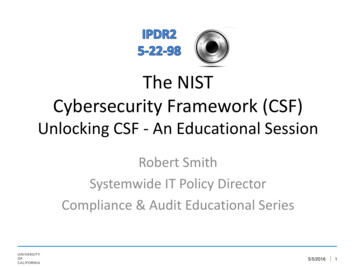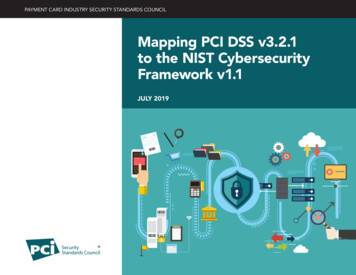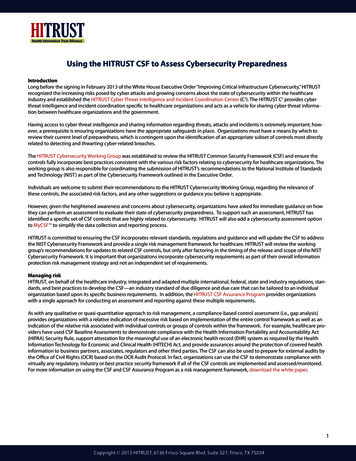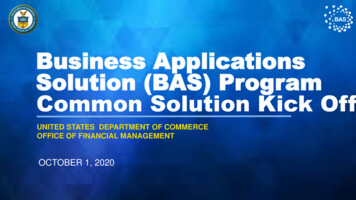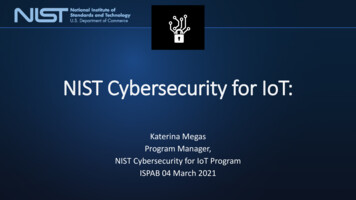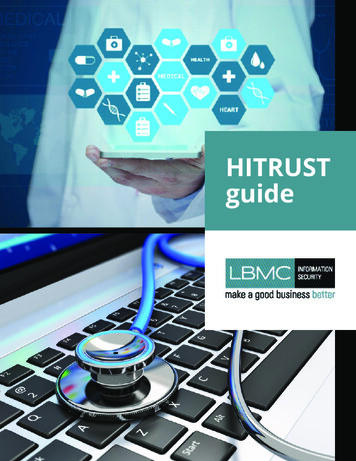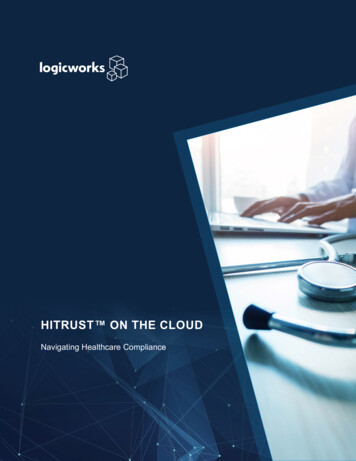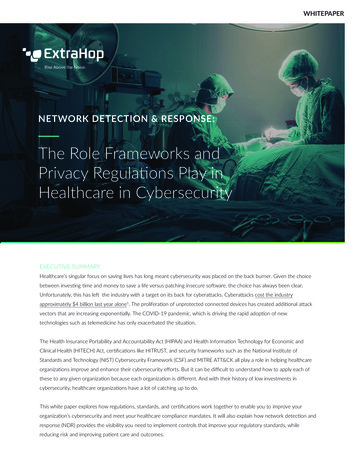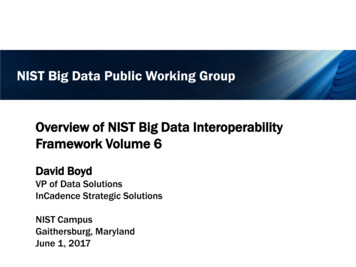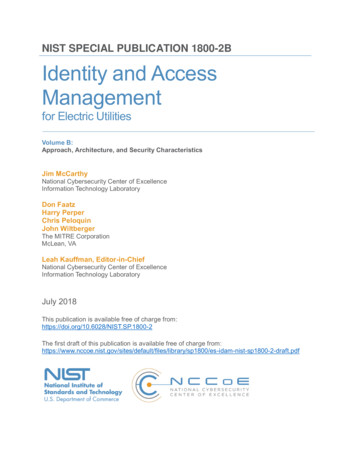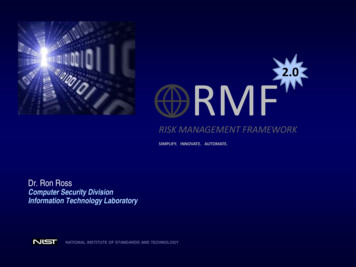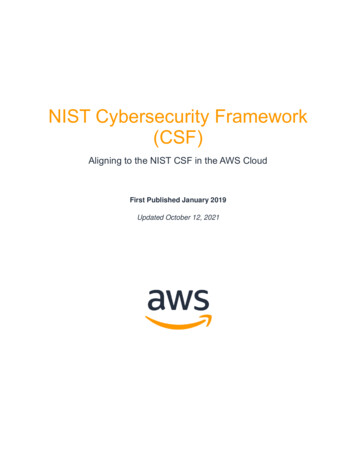
Transcription
NIST Cybersecurity Framework(CSF)Aligning to the NIST CSF in the AWS CloudFirst Published January 2019Updated October 12, 2021
NoticesCustomers are responsible for making their own independent assessment of theinformation in this document. This document: (a) is for informational purposes only, (b)represents current AWS product offerings and practices, which are subject to changewithout notice, and (c) does not create any commitments or assurances from AWS andits affiliates, suppliers or licensors. AWS products or services are provided “as is”without warranties, representations, or conditions of any kind, whether express orimplied. The responsibilities and liabilities of AWS to its customers are controlled byAWS agreements, and this document is not part of, nor does it modify, any agreementbetween AWS and its customers. 2021 Amazon Web Services, Inc. or its affiliates. All rights reserved.
ContentsIntended audience .1Introduction .1Security benefits of adopting the NIST CSF .3NIST CSF implementation use cases .4Healthcare .4Financial services .5International adoption.5NIST CSF and AWS Best Practices .6CSF core function: Identify.7CSF core function: Protect .11CSF core function: Detect .14CSF core function: Respond .16CSF core function: Recover .17AWS services alignment with the CSF .19Conclusion .20Appendix A – Third-party assessor validation .21Contributors .22Document revisions .22
AbstractGovernments, industry sectors, and organizations around the world are increasinglyrecognizing the NIST Cybersecurity Framework (CSF) as a recommended cybersecuritybaseline to help improve the cybersecurity risk management and resilience of theirsystems. This paper evaluates the NIST CSF and the many AWS Cloud offerings publicand commercial sector customers can use to align to the NIST CSF to improve yourcybersecurity posture. It also provides a third-party validated attestation confirming AWSservices’ alignment with the NIST CSF risk management practices, allowing you toproperly protect your data across AWS.
Amazon Web ServicesNIST Cybersecurity Framework (CSF)Intended audienceThis document is intended for cybersecurity professionals, risk management officers orother organization-wide decision makers considering how to implement a new orimprove an existing cybersecurity framework in their organization. For details on how toconfigure the AWS services identified in this document, contact your AWS SolutionsArchitect.IntroductionThe NIST Framework for Improving Critical Infrastructure Cybersecurity (NISTCybersecurity Framework, or CSF) was originally published in February 2014 inresponse to Presidential Executive Order 13636, “Improving Critical InfrastructureCybersecurity,” which called for the development of a voluntary framework to helporganizations improve the cybersecurity, risk management, and resilience of theirsystems. NIST conferred with a broad range of partners from government, industry, andacademia for over a year to build a consensus-based set of sound guidelines andpractices.The Cybersecurity Enhancement Act of 2014 reinforced the legitimacy and authority ofthe CSF by codifying it and its voluntary adoption into law, until the PresidentialExecutive Order on “Strengthening the Cybersecurity of Federal Networks and CriticalInfrastructure” signed on May 11, 2017, mandated the use of CSF for all U.S. federalentities.While intended for adoption by the critical infrastructure sector, the foundational set ofcybersecurity disciplines comprising the CSF have been supported by government andindustry as a recommended baseline for use by any organization, regardless of itssector or size. Industry is increasingly referencing the CSF as a de facto cybersecuritystandard.1
Amazon Web ServicesNIST Cybersecurity Framework (CSF)In Feb 2018, the International Standards Organization released “ISO/IEC27103:2018 — Information technology— Security techniques -Cybersecurity and ISO and IEC Standards.” This technical report providesguidance for implementing a cybersecurity framework leveraging existingstandards. In fact, ISO 27103 promotes the same concepts and bestpractices reflected in the NIST CSF; specifically, a framework focused onsecurity outcomes organized around five functions (Identify, Protect,Detect, Respond, Recover) and foundational activities that crosswalk toexisting standards, accreditations and frameworks. Adopting this approachcan help organizations achieve security outcomes while benefiting fromthe efficiencies of re-using instead of re-doing.Credit: Natasha Hanacek/NIST yAccording to Gartner, the CSF is used by approximately 30 percent of U.S. privatesector organizations and projected to reach 50 percent by 2020.1 As of the release ofthis report, 16 U.S. critical infrastructure sectors use the CSF and over 21 states haveimplemented it.2 In addition to critical infrastructure and other private-sectororganizations, other countries, including Italy and Israel, are leveraging the CSF as thefoundation for their national cybersecurity guidelines.Since Fiscal Year 2016, U.S. federal agency Federal Information SecurityModernization Act (FISMA) metrics have been organized around the CSF, and nowreference it as a “standard for managing and reducing cybersecurity risks.” According tothe FY16 FISMA Report to Congress, the Council of the Inspectors General on Integrityand Efficiency (CIGIE) aligned IG metrics with the five CSF functions to evaluate2
Amazon Web ServicesNIST Cybersecurity Framework (CSF)agency performance and promote consistent and comparable metrics and criteriabetween Chief Information Officer (CIO) and Inspector General (IG) assessments.The most common applications of the CSF have manifested in three distinct scenarios: Evaluation of an organization’s enterprise-wide cybersecurity posture andmaturity by conducting an assessment against the CSF model (Current Profile)determine the desired cybersecurity posture (Target Profile), and plan andprioritize resources and efforts to achieve the Target Profile. Evaluation of current and proposed products and services to meet securityobjectives aligned to CSF categories and subcategories to identify capabilitygaps and opportunities to reduce overlap/duplicative capabilities for efficiency. A reference for restructuring their security teams, processes, and training.This paper identifies the key capabilities of AWS service offerings available globally thatU.S. federal, state, and local agencies; global critical infrastructure owners andoperators; as well as global commercial enterprises can leverage to align to the CSF(security in the cloud). It also provides support to establish the alignment of AWS Cloudservices to the CSF as validated by a third-party assessor (security of the cloud) basedon compliance standards, including FedRAMP Moderate3 and ISO9001/27001/27017/27018.4This means that you can have confidence that AWS services deliver on the securityobjectives and outcomes identified in the CSF and that you can use AWS solutions tosupport your own alignment with the CSF and any required compliance standard. ForU.S. federal agencies, in particular, leveraging AWS solutions can facilitate yourcompliance with FISMA reporting metrics. This combination of outcomes shouldempower you with confidence in the security and resiliency of your data as you migratecritical workloads to the AWS Cloud.Security benefits of adopting the NIST CSFThe CSF offers a simple-yet-effective construct consisting of three elements – Core,Tiers, and Profiles. The Core represents a set of cybersecurity practices, outcomes, andtechnical, operational, and managerial security controls (referred to as InformativeReferences) that support the five risk management functions – Identify, Protect, Detect,Respond, and Recover. The Tiers characterize an organization’s aptitude and maturityfor managing the CSF functions and controls, and the Profiles are intended to conveythe organization’s “as is” and “to be” cybersecurity postures. Together, these three3
Amazon Web ServicesNIST Cybersecurity Framework (CSF)elements enable organizations to prioritize and address cybersecurity risks consistentwith their business and mission needs.It is important to note that implementation of the Core, Tiers, and Profiles are theresponsibility of the organization adopting the CSF (for example, government agency,financial institution, commercial start-up, and so on). This paper focuses on AWSsolutions and capabilities supporting the Core that can enable you to achieve thesecurity outcomes (Subcategories) in the CSF. It also describes how AWS services thathave been accredited under FedRAMP Moderate and ISO 9001/27001/27017/27018align to the CSF.The Core references security controls from widely-adopted, internationally-recognizedstandards such as ISO/IEC 27001, NIST 800-53, Control Objectives for Information andRelated Technology (COBIT), Council on Cybersecurity (CCS) Top 20 Critical SecurityControls (CSC), and ANSI/ISA-62443 Standards-Security for Industrial Automation andControl Systems.While this list represents some of the most widely reputed standards, the CSFencourages organizations to use any controls catalogue to best meet their organizationalneeds. The CSF was also designed to be size-, sector- and country-agnostic; therefore,public and private sector organizations should have assurance in the applicability of theCSF regardless of the type of entity or nation-state location.The CSF encourages organizations to use any controls catalogue to bestmeet their organizational needs. The CSF was also designed to be size-,sector- and country- agnostic; therefore, public and private sectororganizations should have assurance in the applicability of the CSFregardless of the type of entity or nation- state location.NIST CSF implementation use casesHealthcareThe U.S. Department of Health and Human Services completed a mapping of theHealth Insurance Portability and Accountability Act of 1996 (HIPAA)5 Security Rule tothe NIST CSF. Under HIPAA, covered entities and business associates must complywith the HIPAA Security Rule to ensure the confidentiality, integrity and availability ofprotected health information.6 Since HIPAA does not have a set of controls that can beassessed or a formal accreditation process, covered entities and business associates,4
Amazon Web ServicesNIST Cybersecurity Framework (CSF)like AWS, are HIPAA-eligible based on alignment with NIST 800-53- security controlsthat can be tested and verified in order to place services on the HIPAA eligibility list. Themapping between the NIST CSF and the HIPAA Security Rule promotes an additionallayer of security since assessments performed for certain categories of the NIST CSFmay be more specific and detailed than those performed for the corresponding HIPAASecurity Rule requirement.Financial servicesThe U.S. Financial Services Sector Coordinating Council7 (FS-SCC) comprised of 70financial services associations, institutions and utilities/exchanges, developed a sectorspecific profile- a customized version of the NIST CSF that addresses unique aspects ofthe sector and its regulatory requirements.The Financial Services Sector Specific Cybersecurity profile, drafted collaboratively withregulatory agencies, is a means to harmonize cybersecurity-related regulatoryrequirements. For example, the FS-SCC mapped the “Risk Management Strategy”category to nine different regulatory requirements and determined that the languageand definitions, while different, largely addressed the same security objective.International adoptionOutside of the U.S., many countries have leveraged the NIST CSF for commercial andpublic sector use. Italy was one of the first international adopters of the NIST CSF anddeveloped a national cybersecurity strategy against the five functions. In June 2018, theUK aligned its Minimum Cyber Security Standard- mandatory for all governmentdepartments- to the five functions.Additionally, Israel and Japan localized the NIST CSF into their respective languageswith Israel creating a cyber defense methodology based on its own adaptation of theNIST CSF. Uruguay performed a mapping of the CSF to ISO standards to strengthenconnections to international frameworks. Switzerland, Scotland, Ireland, and Bermudaare also among the list of countries that are using the NIST CSF to improvecybersecurity and resiliency across their public and commercial sector organizations.5
Amazon Web ServicesNIST Cybersecurity Framework (CSF)NIST CSF and AWS Best PracticesWhile this paper serves as a resource to provide organizational lifecycle riskmanagement that connects business and mission objectives to cybersecurity activities,AWS also provides other best practices resources for customers moving theirorganizations to the cloud (AWS Cloud Adoption Framework) and customers designing,building or optimizing solutions on AWS (Well-Architected Framework).8These resources supply complementary tools to support an organization in building andmaturing their cybersecurity risk management programs, processes and practices in thecloud. More specifically, this NIST CSF whitepaper can be used in parallel with either ofthese best practices guides, serving as the foundation for your security program withCloud Adoption Framework or Well-Architected Framework as an overlay foroperationalizing the CSF security outcomes in the cloud.For customers migrating to the cloud, the AWS Cloud AdoptionFramework (AWS CAF) provides guidance that supports each unit in yourorganization so that each area understands how to update skills, adaptexisting processes, and introduce new processes to take maximumadvantage of the services provided by cloud computing.Thousands of organizations around the world have successfully migratedtheir businesses to the cloud, relying on the AWS CAF to guide theirefforts. AWS and our partners provide tools and services that can help youevery step of the way to ensure complete understanding and s cloud adoption framework.pdf6
Amazon Web ServicesNIST Cybersecurity Framework (CSF)CSF core function: IdentifyThis section addresses the six categories that comprise the “Identify” function: AssetManagement, Business Environment, Governance, Risk Assessment, Risk ManagementStrategy, and Supply Chain Risk Management that “develop an organizationalunderstanding to manage cybersecurity risk to systems, people, assets, data, andcapabilities”.CSF core subcategories for identify: Asset Management (ID.AM) — The data, personnel, devices, systems, andfacilities that enable the organization to achieve business purposes are identifiedand managed consistent with their relative importance to business objectives andthe organization’s risk strategy. Business Environment (ID.BE) — The organization’s mission, objectives,stakeholders, and activities are understood and prioritized; this information isused to inform cybersecurity roles, responsibilities, and risk managementdecisions. Governance (ID.GV) — The policies, procedures, and processes to manage andmonitor the organization’s regulatory, legal, risk, environmental, and operationalrequirements are understood and inform the management of cybersecurity risk. Risk Assessment (ID.RA) — The organization understands the cybersecurityrisk to organizational operations (including mission, functions, image, orreputation), organizational assets, and individuals. Risk Management Strategy (ID.RM) — The organization’s priorities,constraints, risk tolerances, and assumptions are established and used tosupport operational risk decisions. Supply Chain Risk Management (ID.SC) — The organization’s priorities,constraints, risk tolerances, and assumptions are established and used tosupport risk decisions associated with managing supply chain risk. Theorganization has established and implemented the processes to identify, assessand manage supply chain risks.Customer responsibilityIdentifying and managing IT assets is the first step in effective IT governance andsecurity, and yet has been one of the most challenging. The Center for Internet Security7
Amazon Web ServicesNIST Cybersecurity Framework (CSF)(CIS)9 recognized the foundational importance of asset inventory and assigned physicaland logical asset inventory as controls #1 and #2 of their Top 20. However, an accurateIT inventory, both of physical assets and logical assets, has been difficult to achieve andmaintain for organizations of all sizes and resources.Inventory solutions are limited in being able to identify and report on all IT assets acrossthe organization for various reasons, such as network segmentation preventing thesolution from “seeing” and reporting from various parts of the enterprise network,endpoint software agents not being fully deployed or functional, and incompatibilityacross a broad range of disparate technologies. Unfortunately, those assets that are“lost” or unaccounted for pose the greatest risk. If they are not tracked, they are mostlikely not receiving the most recent patches and updates, are not replaced duringlifecycle refreshments, and malware may be allowed to exploit and maintain its hold ofthe asset.Migrating to AWS provides two key benefits that can mitigate the challenges withmaintaining asset inventories in an on-prem environment. First, AWS assumes soleresponsibility for managing physical assets that comprise the AWS Cloud infrastructure.This can significantly reduce the burden of physical asset management for customersfor those workloads that are hosted in AWS. The customer is still responsible formaintaining physical asset inventories for the equipment they keep in their environment(data centers, offices, deployed IoT, mobile workforce, and so on.).The second benefit is the ability to achieve deep visibility and asset inventory for logicalassets hosted in a customer’s AWS account. This may sound like a bold claim, but itbecomes quickly evident as it does not matter if an EC2 instance (virtual server) isturned on or off, whether the endpoint agent is installed and running, regardless of whatnetwork segment the asset is on, or any other factor.Whether using the AWS Management Console as a visual point-and-click interface,through the command line interface (CLI), or application programmable interface (API),customers can query and obtain visibility of AWS service assets. This reduces theinventory burden on the customer to the software they install on their EC2 instancesand what data assets they store in AWS. AWS also has services that can perform thiscapability, like Amazon Macie, which can identify, classify, label, and apply rules to datastored in Amazon Simple Storage Service (Amazon S3).An organization that understands its mission, stakeholders, and activities can utilizeseveral AWS services to automate processes, assign business risk to IT systems, andmanage user roles. For example, AWS Identity and Access Management (IAM) can beused to assign access roles based on business roles for people and services. The use8
Amazon Web ServicesNIST Cybersecurity Framework (CSF)of tags for services and data can be used to prioritize automated tasks and include predetermined risk decisions, or stop-gates for a person to evaluate the data presented anddecide for which direction the system should take.Governance is the “unsung hero” of cybersecurity. It lays the foundation and sets thestandard for people, processes, and technology. AWS provides several services andcapabilities such as AWS IAM, AWS Organizations, AWS Config, AWS SystemsManager, AWS Service Catalog, and others that customers can use to implement,monitor, and enforce governance. Customers can leverage AWS compliance with over50 standards such as FedRAMP, ISO, and PCI DSS.10AWS provides information about its risk and compliance program to enable customersto incorporate AWS controls into their governance framework. This information canassist customers in documenting a complete control and governance framework withAWS included as an important part of that framework. Services such as AmazonInspector identify technical vulnerabilities that can be fed into a risk posture andmanagement process. The enhanced visibility that the cloud provides increases theaccuracy of a customer’s risk posture allowing risk-decisions to be made on moresubstantial data.AWS responsibilityAWS maintains stringent access control management by only providing data centeraccess and information to employees and contractors who have a legitimate businessneed for such privileges. When an employee no longer has a business need for theseprivileges, his or her access is immediately revoked, even if they continue to be anemployee of Amazon or AWS. All physical access to data centers by AWS employees isroutinely logged and audited. Controls in place limit access to systems and data andprovide that access to systems or data is restricted and monitored. In addition, customerdata and server instances are logically isolated from other customers by default.Privileged user access control is reviewed by an independent auditor during the AWSSOC 1, ISO 27001, PCI, and FedRAMP audits.AWS risk management activities include the system development lifecycle (SDLC),which incorporates industry best practices and formal design reviews by the AWSSecurity Team, threat modeling and completion of a risk assessment. In addition, theAWS control environment is subject to regular internal and external risk assessments.AWS engages with external certifying bodies and independent auditors to review andtest the AWS overall control environment.9
Amazon Web ServicesNIST Cybersecurity Framework (CSF)AWS management has developed a strategic business plan which includes riskidentification and the implementation of controls to mitigate or manage risks. AWSmanagement re-evaluates the strategic business plan at least biannually. This processrequires management to identify risks within its areas of responsibility and to implementappropriate measures designed to address those risks. In addition, the AWS controlenvironment is subject to various internal and external risk assessments.AWS Compliance and Security teams have established an information securityframework and policies based on the Control Objectives for Information and relatedTechnology (COBIT) framework and have effectively integrated the ISO 27001certifiable framework based on ISO 27002 controls, American Institute of Certified PublicAccountants (AICPA) Trust Services Principles, the PCI DSS v3.2, and the NationalInstitute of Standards and Technology (NIST) Publication 800-53 Rev 4 (RecommendedSecurity Controls for Federal Information Systems). AWS maintains the security policy,provides security training to employees, and performs application security reviews.These reviews assess the confidentiality, integrity, and availability of data, as well asalignment with the information security policy.AWS Security regularly scans all internet-facing service endpoint IP addresses forvulnerabilities (these scans do not include customer instances). AWS Security notifiesthe appropriate parties to remediate any identified vulnerabilities. In addition, externalvulnerability threat assessments are performed regularly by independent security firms.Findings and recommendations resulting from these assessments are categorized anddelivered to AWS leadership. These scans are done in a manner for the health andviability of the underlying AWS infrastructure and are not meant to replace thecustomer’s own vulnerability scans required to meet their specific compliancerequirements.AWS maintains formal agreements with key third-party suppliers and implementsappropriate relationship management mechanisms in line with their relationship to thebusiness. The AWS third-party management processes are reviewed by independentauditors as part of AWS ongoing compliance with SOC and ISO 27001. In alignment withISO 27001 standards, AWS hardware assets are assigned an owner, tracked andmonitored by the AWS personnel with AWS proprietary inventory management tools.AWS procurement and supply chain team maintain relationships with all AWS suppliers.Refer to ISO 27001 standards; Annex A, domain 8 for additional details. AWS has beenvalidated and certified by an independent auditor to confirm alignment with ISO 27001certification standard.10
Amazon Web ServicesNIST Cybersecurity Framework (CSF)CSF core function: ProtectThis section addresses the six categories that comprise the “Protect” function: AccessControl, Awareness and Training, Data Security, Information Protection Processes andProcedures, Maintenance, and Protective Technology. The section also highlights AWSsolutions that you can leverage to align to this function.CSF Core Subcategory for Protect: Identity Management, Authentication and Access Control (PR.AC) —Access to physical and logical assets and associated facilities is limited toauthorized users, processes, and devices, and is managed consistent with theassessed risk of unauthorized access to authorized activities and transactions. Awareness and Training (PR.AT) — The organization’s personnel and partnersare provided cybersecurity awareness education and are trained to perform theircybersecurity-related duties and responsibilities consistent with related policies,procedures, and agreements. Data Security (PR.DS) — Information and records (data) are managedconsistent with the organization’s risk strategy to protect the confidentiality,integrity, and availability of information. Information Protection Processes and Procedures (PR.IP) — Securitypolicies (that address purpose, scope, roles, responsibilities, managementcommitment, and coordination among organizational entities), processes, andprocedures are maintained and used to manage protection of informationsystems and assets. Maintenance (PR.MA) — Maintenance and repairs of industrial control andinformation system components is performed consistent with policies andprocedures. Protective Technology (PR.PT) — Technical security solutions are managed toensure the security and resilience of systems and assets, consistent with relatedpolicies, procedures, and agreements.Customer responsibilityWhen looking at meeting the three security objectives of Confidentiality, Integrity, andAvailability, the third can be very difficult to achieve in an on-premises environment withonly one or two data centers. This is one of the greatest benefits of hyperscale cloud11
Amazon Web ServicesNIST Cybersecurity Framework (CSF)service providers, and AWS in particular, due to the AWS unique infrastructurearchitecture.You can distribute your application across multiple Availability Zones (AZs), which arelogical fault isolation zones within a Region. If architected properly with enhancedcapacity management and automatic scaling capabilities, your application and datawould not be impacted by a single data center outage. If you take advantage of all theAvailability Zones in a Region (where there are three or more), the loss of two datacenters may still not have any impact to your application. Likewise, services such asAmazon S3 automatically replicate your data to at least three Availability Zones in theRegion for a provided availability of 99.99% and data durability of 99.999999999%.Confidentiality can be achieved through encryption at rest and encryption in transitusing AWS encryption services such as Amazon Elastic Block Store (EBS) Encryption,Amazon S3 encryption, Transparent Database Encryption for RDS SQL Server andRDS Oracle, and VPN Gateway, or encryption using your existing encryption solution.AWS supports TLS/SSL encryption for all of its API endpoints and the ability to createVPN tunnels to protect data in transit. AWS also provides a Key Management Serviceand dedicated Hardware Security Module appliances to encrypt data at rest. You canchoose to secure your data using the AWS provided capabilities, or use your ownsecurity tools.Integrity can be facilitated in a variety of means. Amazon CloudWatch and AWSCloudTrail have integrity checks, customers can use digital signatures for API calls andlogs, MD5 checksums ca
UK aligned its Minimum Cyber Security Standard- mandatory forall government departments- to the five functions. Additionally, Israel and Japan localized the NIST CSF into their respective languages with Israel creating a cyber
